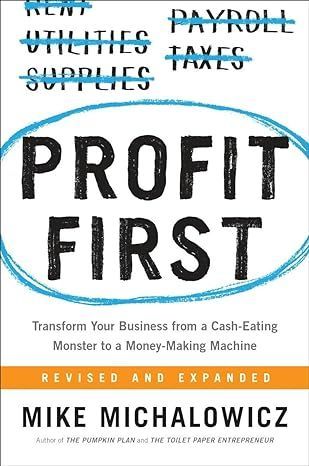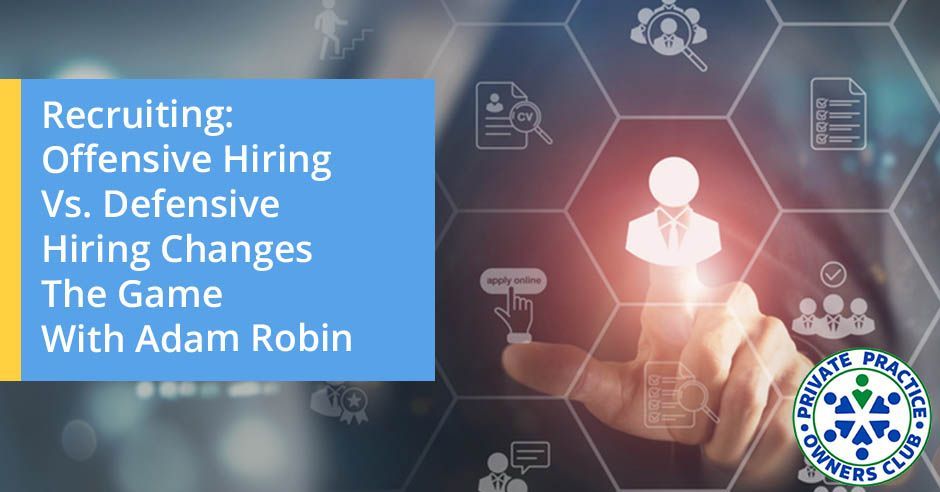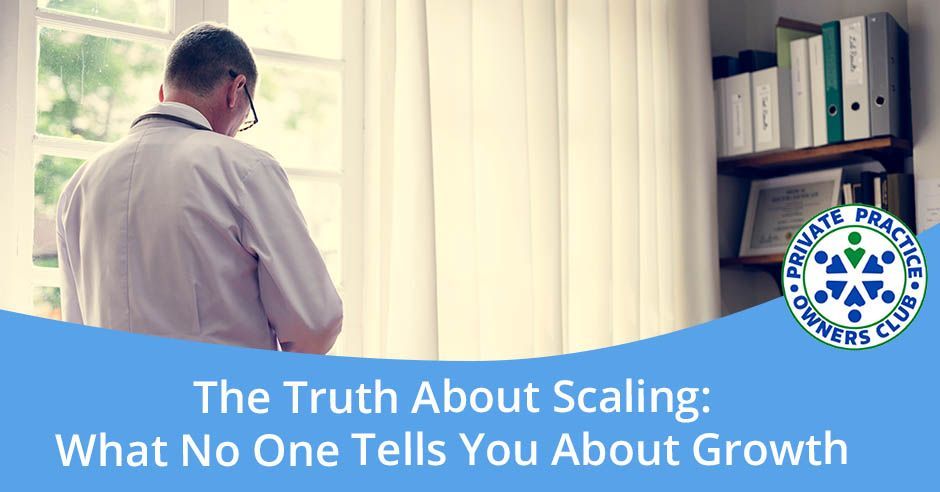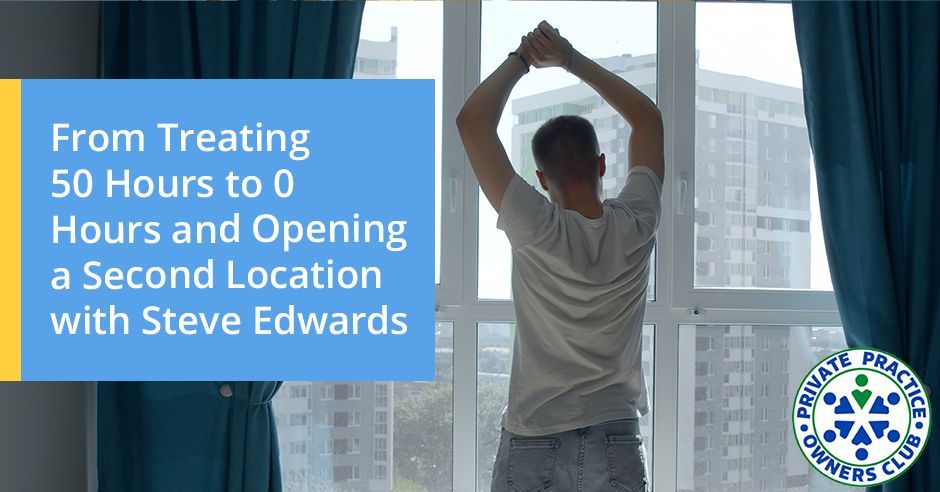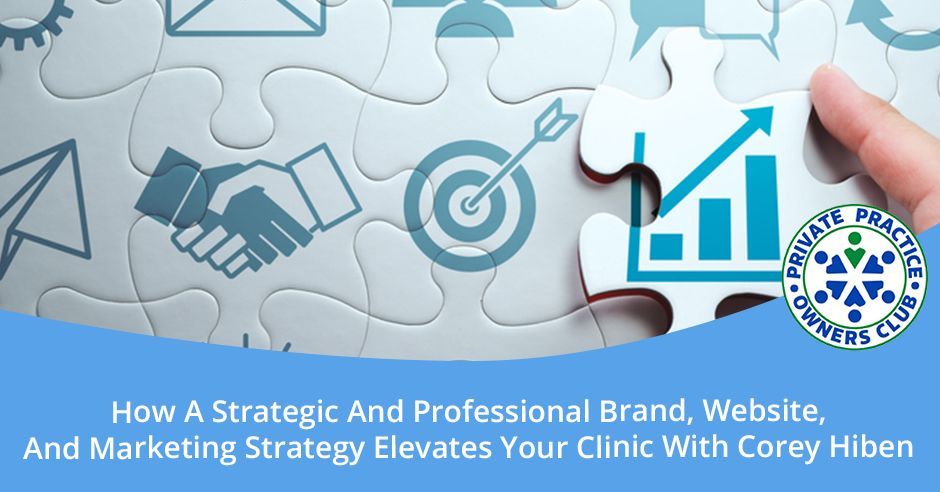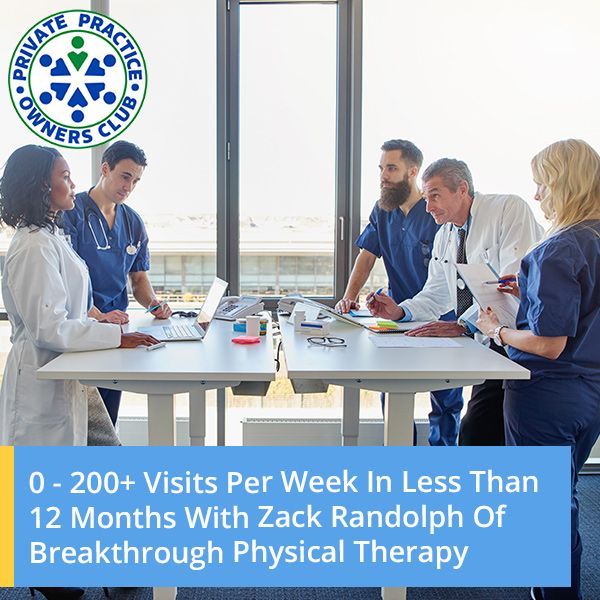In this episode of the Private Practice Owners Club Podcast, Nathan Shields and Adam Robin discuss financial mastery for private practice clinic owners. They share tips and strategies to help private practice clinic owners gain financial clarity and success. They talk about the significance of knowing your KPIs and how they can transform your business. You'll learn practical steps to measure average reimbursement per visit and cost per visit to ensure profitability.
Adam emphasizes how developing good financial habits can empower you to design a system that works for you, while Nathan highlights the necessity of focusing on profits and viewing your clinic as a tool to serve your household. They also discuss the importance of payroll management, understanding break-even numbers, and setting achievable financial goals.
Tune in to uncover the secrets to financial success and take control of your Private Practice!
Want to talk about how we can help you with your Private Practice business, or have a question you want to ask? Book a call with Adam - https://calendly.com/adamrobin/dr-adam-s-30-minute-connection
Love the show? Subscribe, rate, review, and share! https://ppoclub.com/
---
Listen to the podcast here
Practice Owner’s Manual Series, Part 3 - Financial Mastery With Adam Robin
Hello everybody and welcome back to the next episode in our series of the quintessential bulletproof Practice Owner's Manual for Success. Hopefully, you appreciated the previous episode, took lots of notes, and did some homework. Now get ready to do some more work on your business. Get out the patent paper and let's go.
---
I’m with my buddy
Adam Robin and we're now into part three of our PT Manual for Success. How's it going?
It's going well. I had a great day. I've been sick for 4 or 5 days. I'm the kind of guy who got to be going. If I am not going then I'm not happy. I was in a little bit of a slump, but today I got up, I was able to get my run in, and went and met my team this morning. I'm freaking excited that I’m back in my saddle.
I'm excited about this topic because these are some of my favorite episodes. I've had
Eric Miller of Econologics on the show many times. He's a frequent flyer for sure. I love bringing him back because I love talking about these topics. It's all about financial mastery as a practice owner. We're talking about finances and how to set yourself up.
It's interesting how blind many owners are to some of the details in the financials that can make thousands of dollars of difference in profit each month. Little things, looking back. Knowing the difference between NNA versus Medicare billing guidelines, eight-minute rules, and how some CPT codes reimburse better than others, and then the MPPR factor on those codes.
Developing Good Financial Habits
All that stuff can make such a huge difference. We're not going to get into that much detail in this episode. If you want to talk to us about getting into details, you can reach out to us directly, but we're going to talk about the overview stuff and the important things related to the financial aspect of your clinics.
It's about developing good financial hygiene or financial habits and being the designer of your financial situation, as opposed to the victim. Create a system that works for you where you can have more clarity and control over where your money is at, what resources you have available, and more importantly, what leverage you can pull in your business to affect the bottom line.
It's not all about how can we get rich. It's how can we put together some systems that allow us to have predictable financial health in our personal lives as well as in our business. That's something that has to be created. It's not something that's just going to happen because you have a building with a sign on it. You have to design that.
A couple of things come to mind as you're talking about some of the overviews regarding financials. You can listen to some of the episodes with Eric Miller, but a couple of things stand out from past episodes. That is number one, you have to force profits from your company. It is your job as the CEO to force the profit to come from your company in whatever way that is, but you have to push the profits.
You can't just lay back and expect the profits to come to you. Simply in a private practice setting, our margins aren't that great. You have to drive the profit. The other is the mindset that the clinic should be working for you instead of the other way around. It's that typical mindset of you don't own a company, you own a job.
When you're a small business owner and you can get in, you can get stuck as to how that organization should look. Honestly, if you were to map your life into an organizational chart, at the top of the organization is your household. It's not your company, it's your household. Below your household is your business. The business serves the household and the money that's created by the company should be driven towards your household along those same lines as an organizational chart.
Having those two mindsets puts you in the more powerful, proactive, and change agent position instead of being passive about it and saying, “Whatever is left over, I'll take home. I'll pay myself last.” That's not the mindset you need to take if you're going to be profitable in your business. This business is here to make me and my household money to prepare me for retirement and set up my kids for a successful future. That's why I did this. It's not selfish to say that.
As I heard you talking, and I haven't described it like this before, that division came to my head. I imagine everybody has in their house that cheese grater. It's that silver thing with a handle on it and there are holes on different sides. You have a block of cheese and you want to shred some cheese. If you want to create shredded cheese, you have to push it through the holes that you design.
Otherwise, you're not going to get shredded cheese. You're going to get something different. You might get some crumbles and some blocks and some chunks or none at all. You have to create an avenue of friction that you have to push your efforts through to create the product that you're looking for to get the cheese.
In this instance, you're operationalizing like the cheese grater. You're pushing your efforts, energy, onboarding, training, and all these things through this product. At the other end, you get the product of profits that you can reinvest back into your business, into your family, and your people. It's not like you woke up and you got shredded cheese everywhere. You got to create it. Come on, people, let's go.
Unfortunately, a little bit naivety as a small business owner, because what we know is whatever function we're working in, physical therapists, optometrists, and veterinarians, we can do that well, but owning a business is relatively new for everybody. Pushing the profit wasn't necessarily taught to us and that's why we're doing this.
That's why we're doing it. That's why we're here.
Key Performance Indicators (KPIs) For Financial Health
That's why we're doing it. Let's get started at the very top and start with some of the KPIs that are important to know. When we're talking about KPIs, the traditional ones come up, whether it's visits per week or the number of new referrals per week. General revenue numbers are there. There's more to it that I think people need to know.
These should be readily available in your EMRs at this point. If they're not, I'd highly recommend you talk to the customer service person who runs the software. Average reimbursement per visit. This and the average cost per visit go hand in hand and you need to know these two things. The average reimbursement on average needs to be higher than your cost of running the business so that you know you're making a profit on each visit. Those two things are the basic KPIs that I would start with.
I network with owners all the time and I'm almost positive, because I've been doing it for long enough, that if you ask any owner especially those who are in the network, what are some of the biggest challenges they're facing right now, it's declining reimbursements. How do I create profitability in my business? The next question is, what's the spread between your cost per visit and your reimbursement per visit right now? What does that mean? How do you create that? You can't manage what you don't measure. You have to know that.
You can't manage what you don't measure.
If you don't have clarity on that, I'm going to smoke you. You have to have clarity on what is your average reimbursement per visit predictably based on the patient demographics or the insurances that are coming, that you're seeing monthly. When you put all those together, what is the average reimbursement you're getting every visit? Likewise, what is the cost?
It's a simple formula. Take your gross revenues divided by the total number of new patients in the previous six months or twelve months, whatever it is. The same thing with your cost per visit. If you need to meet with a CPA and figure that out, go ahead, but take your gross expense line divided by the same number of new patients in that they need to get your costs.
We don't know this one part. It is what insurance uses against unknowingly for the owners. That is they're going to offer us a contract if we want to be in network with them. If we don't know our cost per visit, then we don't know if we're making money on that contract or not. In the physical therapy space, typically United Healthcare contract might be $60 to $65 per visit flat rate.
If you can't even project what your cost per visit is going to be when you open up your clinic, you're going to unknowingly or ignorantly sign that contract because it gets you patients. That's why the people around here take United Healthcare. Doctors are going to refer patients who have United Healthcare.
Blindly, we're signing these contracts that are below our cost per visit. Some people might say, “That's a loss leader.” If you're okay with that, then you might be better served by letting that patient come in and giving them $20 each time they come in. “Thanks for coming. Why don't we save each other's time and let me give you this $20 and see you on Wednesday?” That's one thing that works against us in that particular scenario because we don't know our cost per visit. If you don't know your cost per visit, you don't have the business yet. That's why you build out a pro forma.
I don't know if we talked about that before, but building out a pro forma with your CPA’s help if you need one or a bookkeeper that assesses, “Maybe these are the costs that we're looking at going forward. This is going to be the average cost based on the number of visits we're predicting.” What's that cost going to look like? There are easy ways to come across those numbers, but they're also super valuable in knowing which contracts you're going to want to sign up for or not.
At the end of the day, our purpose is to help owners regain control. We're helping them regain control. Let's take the reins. Setting up your KPIs, especially your financial KPIs is the one tool that you have to regain control of what you want to create because once you have clarity there, you can do all kinds of stuff. You can set your productivity expectations with your team.
Objectively and not emotionally. We need to do X to achieve Y. That is a math problem. It's not an emotional problem anymore. It's a math problem. There's a lot of power that comes from that. Not only that, but we can project revenue. We can project collections. We can project things. We can have more certainty about the money that's going to be coming into the bank or the money that we're going to have to spend every month. That gives you a lot of power as the owner.
Empower in decision-making. If I know the data, then I can make a good decision.
If you know the data, you can create certainty. If you can create certainty, then you're going to take action and you're going to make decisions. You're going to make decisions through that certainty. If you lack clarity and there's a lot of fear in security around your money, you're going to get paralyzed. You're going to be in that fear zone. That's where a lot of owners stay. They're in that zone and they feel like it's because new grads don't want to work for less and I can't make money and this and that. You don't have control. Once you get control, there's a whole new mountain of possibility that you can climb. Know your numbers.
Once you get control of your numbers, there's a whole new mountain of possibility that you've got.
Profit margin is one that business owners should know in general. If you don't know how to get it, talk to your CPA or bookkeeper. They'll teach you. Pay them to sit down with you for an hour and go over it. That's going to be one of our recommendations later on, but for the sake of the KPI section, get to know your profit margin. In general, in the physical therapy space, if you're in the 10% to 12% profit margin, you're about average.
If you're in the single digits, you're below. If you're getting above 15% profit margin, then you're doing well. Honestly, if you're not making a double-digit profit margin as a business owner, then I question whether or not it's worth it for all the risk and headache that you're taking on. If you don't see a way to get that double-digit profit margin either, then you might want to consider different ways of doing business. You can stay in the space, but maybe you need to modify some things.
In addition, I want to add there is there are situations in which single-digit margins are appropriate, but you better be scaling your business very rapidly. It's going to cost you money to grow your business, but you better be opening up clinics every year and still having those single-digit numbers.
Yes, because your expense line is high because of marketing.
Correct. You're hiring therapists every month and if those types of things are happening, different story. We're talking about operational capacity. You're leaned out and you're stable. I mean 20% margins is very achievable even in the network, even with UHC. You can do it.
Are there any other KPIs that stand out to you outside of those? We missed a couple.
Not that we have to dive into all of them because there's a bunch that we could, but the one metric that helped me is the percentage of income being spent on payroll. My buddy, Will, told me one day, “There's one expense line that will bankrupt you and it's your payroll.” If you get the payroll number right, it's almost hard not to make money. You got to be silly. If you get your payroll up to 60%, 70%, or 80%, you're going to be broke.
We're talking about 60% of the revenue.
If you're making $100, you can't spend more than $60 on payroll.
When you say payroll, it's payroll plus benefits.
Payroll, benefits, transaction fees, all the employee stuff. We need to keep that number. Back in the day, it was under 50%. It's a lot harder to do nowadays, even somewhere below 60% is achievable. If you're lean, run it on 55%. You can do it but if you keep that number around 55%, you still have 45% to work with. Big difference. You have some freedom. You have some flexibility.
It's going to be important for you to make sure you're not paying your therapist more than you can afford and you're offering benefits packages that fall within that framework. Also, you have you establish a production level, whether that's units per visit, units per week, units per month, or whatever it is that you decide that satisfies that metric, that keeps that expense line under 55%. That's the biggest problem. You solve that problem, you have a lot of money to play with now.
Now you know what your acceptable salary range is for a physical therapist. Going back to knowing the numbers and the power it provides, someone says, “I want $80,000.” If you know your numbers, you can think in your head, “If I'm going to pay them $80,000, they need to be producing this much.” I can come back and say, “Sure, if you want $80,000, I can do that.” I'm just throwing numbers out there. “I'm going to need you to see 65 visits a week with an average of four skilled units per visit. Can you do that? If you can, then I can pay you $80,000.” I can justify an $80,000 salary.
That's the power of it or if someone says that they want to raise, then you could say, “That's fine.” Either there's room for them to receive a raise at their current production level, or you need to say, “If you're going get a raise, can you do these things for me and improve production to justify the raise.” That's the power of knowing these numbers in your negotiations as it pertains to salaries. I could see in those that the percentage number would vary from month to month. The biggest determining factor would be if we had three payrolls that month instead of two.
Yes, there are two months out of the year. We had one. It was this past month.
The other one is low production months. I don't know about you, but we measured monthly. On those low production months, that's when the average payroll related to salary percentage would skew to 65%. We hardly made anything that month. Maybe it was a thousand dollars in the negative. I'm glad that you tied not salaries in there, but also to production levels. Pushing production levels drives this number down. The more patients they see, the more they generate, the better that percentage comes in.
That's right because you could focus on revenue generation. That number was big. Once you measure that number, we measure that number monthly as well. Once you measure that 3, 4, 5, or 6 months in a row, you can start seeing, “If I did this, that would give me this.” Great. Now you can start putting together a plan. You could build your business around it.
Now you're in control. You have an objective and then you can set goals. You can even set bonuses on that stuff. Let's get the team involved. The big metric is the percentage of revenue being spent on payroll. Before we started press play, there was a handful of others that we talked about. Number one was your break-even number. The break-even numbers are big. Do you want to tell them a little bit about what that is?
I learned this one from Eric Miller. I also learned it from Mike Michalowicz,
Profit First. Great book, I would recommend it. Usually when you think of breakeven, how much revenue do you need to generate to cover all your expenses? Eric Miller and Profit First would say, “You're not in business to cover your expenses.”
Your business serves your household. If you're covering expenses, then your household has nothing to live on. Covering expenses plus 10% is going to be the break-even number. You always want to build in the profit margin because of the pressure that you put on the business with the additional 10%, surprisingly, it starts to generate that for you.
It's some universal known truth that once you apply that number to the business and work for it, it starts to generate the added 10%. You take your average monthly expense rate and add 10%. That's your break-even number. You can look at the break-even number in terms of dollars, and that's where you'll initially go.
What I would recommend you do is also break it down by the number of visits in a given month. Take that break-even number for a month, the expense line plus 10% divided by the average reimbursement per visit. That'll tell you how many visits per month you need to see to break even. If you want to go further, you divide that by 4.2, which is typically how many business weeks or business days there are in a month, and then you can get your weekly break even.
That helps a ton. That gets me back to how many visits this clinic needs to generate. If I'm going below that number, now I know that the sirens need to be going off. We need to have some conversations and some marketing wheels need to start spinning. Everyone knows that this is the black line. We do not go below this black line. The power of that is you can look at your schedule for the week and say, “We are recovering expenses plus 10%. Now let's look at this. Here's our next goal.”
If you want to break it down further, you can tie that into the number of providers that you have and how many they need to see per week to hit the break-even number and set those expectations as well. I wouldn't set provider expectations based on the break-even number. I'd add a cushioned in a little bit more and not leave it at the break-even number, but there's a minimum expectation there at least.
That's great. I think we've covered that pretty well. The bottom line is creating a system in which you can start measuring more specifically how to create more profits in your business. It will give you a ton of control.
We didn't start this one off like we have in the previous two and that is to take out your paper and your pen because you're going to take notes.
Get some notes. We're on page one, chapter three. At the end of this, I'm keeping my notes myself and I'm going to wrap this up into a bow and you're going to have some homework. I'm going to expect that you're writing down some action items that you're going to start implementing into your business because we want to see you win.
Under chapter three, write it at the top. Financial Mastery, KPI is the first section. Talked about average reimbursement per visit, cost per visit, and profit margin. We talked about the percentage of salary, payroll versus gross revenues percentage, and also break-even numbers.
More importantly, maybe not more importantly, but also as important, developing a disciplined rhythm of measuring that. Every week, month, quarter, and documenting all the formulas on how to measure it, and where to get the information. All of that's documented, all of that's on paper, and committing to making decisions based on the data. If you do those things, give me a year and your whole business will change. If you do those things, you're going to be outperforming 90% of most clinics.
Monthly Meetings And Understanding Financial Reports
We usually measure them monthly. We had two separate meetings. We had the billers meeting that had to do with the average reimbursement and the break-even. They're focused on other things as well, what's in the AR aging and that kind of stuff. That's a different conversation. Also, the CPA visit. Some people might have a CPA, some people might have a bookkeeper, or whatever it is.
You're looking at some of these other numbers monthly, the profit margin, the profit and loss statement, and the balance sheet. If you don't know how to read them, spend an hour each month with your CPA or bookkeeper to read them and have them teach you. Also knowing what your profit margins are and looking over that pro forma is projecting forward. These are the things that you should be discussing regularly with your CPA and your billing team.
Chapter Three, section B is about billers or billing teams. How many times have you heard people complain about their biller? All the time. Here's the thing, guys. It's still an employee that you have to manage.
Even if it's outsourced.
It's your fault. It's your problem. It is not going anywhere, so grab the reins and take control. Step one, email your biller right now. Let’s pause, email your biller, and say, “We are going to start meeting every single month and we're going to put it on the calendar and it's not moving. In that month, I need you to let me know the financial health of my account.” There are some key statistics that you'll probably start measuring like the projections, how much you collect, reimbursement per visit, and your aging report. You need some information from them and you need to be able to hold them accountable. Big piece. That's important.
I think that's where people fall short. There are two things. You said one important thing, meet monthly. I see a lot of owners simply receive the billing reports via email. More than likely don't know what they're reading and they get maybe a short quick summary in the email. Rarely do I see owners having in-person virtual billing meetings, and reviewing the reports.
Accountability And Communication With Billers And Accountants
There's one part that I see that's wrong with most owners. The second is that they don't know how to hold them accountable. They don't know what they're looking at, so they don't know what's good and what's bad, what needs to be red-flagged, and what is normal. That kind of education is important. I don't know if we can get altogether into it in this episode.
I have episodes with
Will Humphreys where I go over it and from a few years back. You can even reach out to us again and we can talk you through some of those. It's projecting forward. What were they supposed to collect in the month of June right now? It's the first part of June. You should know what to expect from your biller based on May's visits.
If you had 500 visits and each visit's average reimbursement was $100, then you should know in June, roughly you should be collecting $50,000. If your billers are off of that by more than 10% or 15%, then they need to answer some questions. Looking forward, there are the average reimbursement rates.
There's the average bit charge per visit that should stay pretty steady unless you make some changes. If you're going to start billing therapeutic activities a little bit more, you should see that number start ticking up a little bit higher than in previous years. You look over the AR aging report quickly. It's the 80-5-5-10 rule.
Zero to 60 should be 80% of your outstanding AR, 5% in 60 to 90, 5% in 90 to 120, and 10% in 120 and above. For AR aging, that's a rough one. If you didn’t catch it, write it down 80-5-5-10. We always would look at denials. Look at the denials. Even if you don't know anything about billing, look at your denials either by the patient or I would recommend by the payer.
Blue Cross Blue Shield, we've got $15,000 sitting in the 120-plus day AR aging report with Blue Cross Blue Shield. What's happening with those and why are they late? Blue Cross Blue Shield usually pays within 3 to 4 weeks, maybe. In some cases, it does quickly, but why is all this money sitting at 120-plus and what are you doing about it?
That's where they need to be reporting to you. These are the calls that we made, this is what's being said, this is what was sent. I need that accountability from my billers to know exactly that regarding the payers and the patients. Especially those that have a $500 or $1,000 balance. When was the call made? What did they say? How many letters have been sent? All that stuff. I want to know that in my monthly billing meeting.
What I'm hearing is that Chapter Three, section B is The Biller. Two big questions are, number one, when will you establish a meeting with them? Number two, how are you going to hold them accountable? Maybe the first phone call with them is, “I don't know what I'm doing. How do I hold you accountable?” They should be able to teach you.
I had those exact questions for my biller. I would ask her, “How are you going to steal from me?” I would say, “If you wanted to hide money from me, where would you hide it in these reports?” I was fourteen years into business at this point when I finally got my crap together around meeting with my biller. Not surprisingly, that's when I profited the most. It was towards the end when I finally held my biller accountable. It's like looking at projections for the upcoming months. May you have many visits. Everyone says, “All the entrances pay on a different schedule.” I know but it all works out.
You have to take the law of averages.
We're not looking month to month. Over six months that all averages out. It worked out that way. When I had 500 visits and a $100 visit, I could expect, say in this month, I'm going to get around $50,000 give or take. If it was short, if it was $40,000, they've got some questions to ask.
There’s no 10% variable exists. It doesn't exist.
You got to say, “What's going on and why? Where was the hiccup? If we got $60,000, did we have a lean patient that came in that we weren't expecting reimbursement for or something like that, a worker's comp, big payment, or whatever?” You can look at some of those averages, but the AR aging is important. The average reimbursement per visit is important, and the charge per visit is important.
The denials by the payer are super important. We didn't go over the balances of the patients all that much unless they were over $1,000 each or individually. That's when we focused on the patient balances. It should be zero and I'm going to say it here. Check my podcast video
Kristi Plunk, and get credit cards on file for every patient. You will never have to worry about patient balances again.
That's all I'll say. It would make you much money if you do that. If you tune in to this episode and do that one thing where every patient puts their credit card on file and charges their balances at the end of each month, game changer. I would venture to guess you'll make another 5% to 10% in revenues by doing that one thing.
I'm going to make the next section super easy and it's your accountant. You hit on that stuff. Your accountant is that other person on your financial team that you never talked to and you don't know what they do, just like your biller. Copy all the things that you're doing with your biller and paste them with your account.
Monthly meeting with your bookkeeper or somebody on your financial team. The meeting is like, “Teach me. Show me what I need to know. I want to learn what you know. What's a profit and loss statement? How do I read that? What are the trends? How much taxes do I owe? What are the things I should be considering from a financial perspective in my business this quarter?” Those are all important conversations that you should have. Everything you're doing with your biller, do with your accountant. Is there anything I missed?
Meet them monthly. They're going to charge you for it. Plan on paying them for it. This is the cost of education. Put it under education. It's part of being a business owner. You're going to meet with your bookkeeper or CPA. A noticeable change in my capabilities as an owner, my confidence, and my power as an owner increased once I did this with my bookkeeper.
I had to be the one who reached out to him and said, “I don't know what I'm looking at. I've owned my business for ten years at that point. It's a shame. Can you teach me how to read this, look at cashflows, and all that stuff?” We would sit there, even as I got comfortable with profit and loss, we would pull up the screen and look at it with each other and compare expenses month to month, this year to the previous year. We'd look at the profit margin trend.
We'd talk about what taxes are going to look like this upcoming year. Before that, my conversations with my bookkeeper tended to be around tax time. I'd get the, “You had an amazing year. Congratulations.” Can you send a check? I think one year it was, “Can you send $60,000 to the IRS? I said, “What?”
I never wanted to be in that spot ever again. That's where we started doing this and taking control, being proactive saying, “Based on my revenues from this past quarter, how much should I set aside for taxes in April? How much should I pay if you're paying quarterly?” Just to make sure we're on pace, so I'm not coming out of pocket a lot when April 15th comes around. Those conversations were super important.
Take it a step further, “I'm looking to hire a physical therapist. This is the salary I'm projecting. How does that change my break-even point? How much more revenue do I need to generate per month and how many more visits do they need to see per month to justify this new salary?” Those kinds of conversations or at the beginning of the year, “Let's build out a proforma, a budget for the next twelve months. What does that look like? How much do you predict to grow over the next twelve months and how are your numbers going to change accordingly? What can your profit margin look like?”
Going back and looking at the current month's financials against what your budget was or what you were predicting on your pro forma. There's a lot you could do with your CPA and this is a good rule of thumb for the CPA and the Bills and Collections team is find one that will communicate with you. If they're going to hem and haw and say, “I don't do that,” “I can find someone else. Thank you.”
I want someone responsive to my emails. They're going to communicate with me when I say I need a quick call. They'll say, “Let's get together in the next day or two. Here's my schedule. I want to meet with you monthly.” At this point in my life, those are givens. If you're not willing to do that for me, you're not going to be part of my team.
What I heard is in those relationships, you are the leader and you are the person who's in control of that relationship.
They're serving you. Sometimes you get into those meetings and they're teaching you and that's fine. You can feel you're submissive. What do you need next? No report to me. You are my vendor. Report to me your efforts for the past month, please.
Look at them as if like they're anybody else that's on your team. They're a tech or they're a PT or they're a front desk person. You don't go into your business asking permission from your team to make decisions on how things should be going. When you enter into those conversations, “This is how I envision this setting. This is what I need from you. Is there anything you need for me to move forward?” You're taking ownership of that.
“Can you have these reports ready for me and be ready to explain them when we meet, please?”
Proactive Financial Management And Cash Flow Planning
Step up with your biller and your accountant, and be a leader. Last thing I want to cover. By the way, I'm not a financial expert, but I've learned a handful of things from Nathan and guys who are a lot smarter than me. Managing cash is important. Cash comes and cash goes. A lot of things changed for me whenever I got a little bit more structured and disciplined in how I was managing the cash that I had in my business.
Cash comes and cash goes, which is why managing your finances is crucial. To achieve this, you need to be a little more disciplined with your money.
Things setting up more than one bank account, more than one checking account for specific purposes in your business. An operations account. This is the money in and money out. Maybe you have a tax account. Every month, I'm transferring money into my tax account, depending on what my CPA is telling me.
Maybe you have some type of business expansion account or a savings account where you're taking all the leftover profits and you're putting it into account planning for that next investment. Whether that's a piece of real estate that you're looking at, an expansion in your business or you're hiring a new PT. Plan for those things by moving your money and being a little bit more disciplined about your money. It is important. Is there anything that you have that you'd love to share?
I did a full episode on this with
Eric Miller back in 2020. There were plenty of financial concerns during that year. I don't remember why but he broke down exactly all the accounts that you should have as a business owner. The operations account and the tax set aside account are examples. These can be regular flat payments as you get comfortable with knowing the overall number that you need to pull from for your taxes.
If you know you're going to set aside $20,000 for taxes in a given year, then you're going to set aside $1,600 a month so it's not big chunks every few months. Set aside $1,600 a month and you'll have your $20,000 at the end of the year. The operations account is where money comes in and that's where expenses get paid. That's where reimbursements come. You take that and put it in your tax account. That's your research and development. Every normal company has a research and development arm. That's where you'd put this money set aside for growth.
There's always the rainy day fund. We wouldn't take any distributions from our companies unless our rainy day fund was there. For us, we decided that was 3 or 4 payrolls worth. We took the amount of payroll on average and times that by 3 or 4, and that was our rainy day fund. If we got rid of all the expenses and slimmed down, we knew we could make it for probably more months, but that was a general rule of thumb.
Some people will say six months of expenses and that stuff. Fine, keep building it up, especially the bigger you get. People during COVID, wish they had twelve months of expenses. You can look at the rainy day fund as putting in a certain number of months of expenses in there. What we had behind that rainy day fund was a line of credit.
I think our line of credit was $250,000. You're not paying for it unless you use it. There was an annual fee of maybe a couple of hundred bucks. I don't know if that's changed much since then, but we had access to a ton of cash if we ever needed it. That was also partially our rainy day fund, not just the cash that we had, and then the retirement fund.
This is a big part of Profit First. Eric Miller is a big fan of this. Not that he has read Profit First, but he has used it. His spouse uses this as well. That is set aside 10% of your revenues off the top every month into a retirement account. It's usually a savings account. That's a little bit harder to get access to. If you make $50,000 in a given month, you put $5,000 in the retirement fund. If you can't figure out how that's going to work initially, start with 2% or 3%, and then build up a percentage point each month.
I saw this happen with one of my coaching clients, Graham. He started before COVID and kept it up during COVID and it wasn't an issue for him at all. He started with 3%, 4% or 5%. By the time COVID hit, he was setting aside 10%. He kept doing it. He was still religious about it. He said, “Nathan, I've got $40,000 sitting over here in this little retirement account. What am I supposed to do with it?” Set aside for retirement. It's not to go out and buy a new car.
The money's purpose, should you be intentional about it, is to be put into some growth vehicle that's going to make you money, not your salary, but also set your household up for retirement. Those are some of the most important accounts that I can think of. I think if you tune in to that episode, we might've talked about 6 or 7 different accounts, but those are the main ones. If you're hitting those, then you're doing well.
Each of those topics, we're doing an overview of these things and we're trying to cram a lot of information into a short time, but we could have multiple series of episodes on all of those things. What I'd like to do is like I did last episode, wrap this up into a bow where people could walk away with some tangible action items that they can implement into their businesses.
By the way, these are the small things that add up over time and lead to massive results. It's not like Nathan's famous saying, “We're hitting singles here.” We're hitting singles. It's all these little small things that are getting the flywheel moving. A year from now, you keep doing these small things that things are going to be moving fast, you can't even slow it down.
You have your Owner's Manual. You flip it over to page three, and the topic is Financial Mastery, Financial System. Part one is you're going to set up a KPI dashboard in your business. All the key statistics that are important in your business, from front desk to clinical to financials, all those things. You're going to develop a rhythm of measuring cadence either weekly, monthly, quarterly, or annually.
Document that and write that down. Also, included in that are the formulas for each of those things. Where to find them in your EMR or your profit and loss. That way you can train others to get them for you, and then commit to making decisions. What is your decision-making framework going to be with using those statistics? That's section one.
Section two is your biller. Nathan went over tons of great stuff you can do with your biller. The big takeaway is number one, you're scheduling a meeting rhythm with them, whether that's weekly, bi-weekly, or monthly. I would say at least monthly.
It has to be monthly and at least the set time and day makes it easy.
First Monday of the month, every month at 8:00, whatever.
That makes it easy for everyone so that you're not looking at the calendar every month.
The project becomes, “I'm going to lead the biller, and I'm going to hold them accountable.” How do I hold them accountable? You need to know enough about billing to be able to hire your biller and hold them accountable at some point. That's your project. Section three is the same thing with your accountant.
You're going to be meeting with them at least monthly, going over some key statistics and you're going to be learning from them and how do you hold them accountable and with their job. Lastly, you're going to have a cash management system. Nathan talked about a ton of things, but the main things were we're going to set up some accounts and you're going to go to the bank, open up some checking accounts, and name them.
If you need more clarity on how to name them and all those things, go back to previous episodes. Nathan talks about that stuff a lot. You're going to schedule routine transfers from your big account into these accounts every month. You're going to have to automate it. It's going to be 10% in this account, 5% in this account, whatever it is but you're going to set it up and you're going to commit to it.
Also, make sure that you're saving for a rainy day fund and opening up a line of credit. Having that on tap at all times. If you do those things, you're crushing it. Now you know what to do. Do it. If you do it, take action towards those things, even if you don't fully understand them, email me, shoot me a DM, join the Facebook group, and ask questions. You can figure those things out. Get busy doing those things and I promise you, it'll make a massive impact on your business.
It will. Do we have time for one more thing?
Of course, we do.
If you did Kristi Plunk's thing by keeping all credit cards on file, it makes you another 5% to 10% in your business. This will make you another 5% to 10% in gross revenues in your business. That is managing your over-the-counter collections at the front desk. I've talked about this on the show plenty of times, but the front desk's responsibilities are to get patients in the door and pay for that service at the time of service. Don't let it slip.
The percentage of money that you should collect at the time of service should be 100%. I'm including deductibles, co-insurances, and copays. All of it. People ask, “How do I know how much to collect for a deductible?” What's your average reimbursement for is it? Round that up or down to a nice even number and collect that at least.
I recognized how much money was lost and probably, honestly stolen. Once I finally figured out how to manage the cashflow across the front or at the front desk, by having a spreadsheet of what was expected to be collected versus what was collected every day. That was reconciled every day to what they received in cash, checks, and the credit card batch receipt.
We’re doing that and putting it in an envelope and then throwing that in the safe every day, sending the report to me and the biller every day so that it all reconciled on the EMR as well. I was depositing lots of money in the bank account. I never had this money before. Where did it come from? Number one, we weren't collecting it before.
Number two, there might have been some pilfering, but it made a huge difference in my cashflows, honestly, because we collected everything at the time of service and that was a KPI to hold the front desk accountable. 100% was the expectation and if it was 95%, you needed to tell us and have a good answer in a way in which to collect the money by the next visit, “They forgot their credit card.” Did you get the credit card on file? Number one. Number two, why don't you call them right now and get that payment instead of waiting for them to come in?
Look for over-the-counter collections opportunities to hold them accountable, and have a spreadsheet that they reconcile daily at the end of the day. Looking at the next day, write down all the expected collections for the upcoming patients that are coming in tomorrow. Use that same sheet for tomorrow's patients and check off who collected what and in what form and what was the balance, by cash, credit card, and check. Make sure that reconciles and put that in the safe every night at the end of the next day. That's another way to make a huge amount of increase in your cashflows if you're not doing it already.
You hit on something right there that was important. You highlighted some of the limiting beliefs that owners might have. “How do I do this? How do I do that?” I get it. You're not the only person that has those beliefs. I have them, and Nathan has them. We all have them. What I'm telling you right now is there are people out there who are way less qualified than you who are rushing it right now because they're willing to push through that and do it anyway.
They're making bigger impacts. They're giving their team more opportunities. Their team is growing. If you can find a way to tell them that voice to shut up and do it anyway, even if it's scary or uncomfortable, and commit to it, you will grow into a more powerful leader, a more powerful owner and you'll get way more of what you're trying to create.
If you can silence your inner critic and take action, even when it's scary or uncomfortable, you'll become a more powerful leader and owner, achieving more of your goals.
I had a patient do this exact thing with the credit cards on file thing. He said, “You know what? We're going to collect credit cards on file. If you don't want to do that, I'm sorry, we can't see it.” What he recognized was that the people who wouldn't do it were the people who weren't paying their balances and ended up on the 120-day aging report with $680 that they weren't able to collect. Those are the people that weren't willing to put their credit cards down.
He got on the phone with one of them. He said, “We need payment. You got this balance. I'm going to charge your credit card that we have on file.” “No one else does that. Why would you ever do that? I've never had this before.” “We're going to charge you anyway.” You give Amazon your credit card. There are a lot of online sites that have your credit card information than me. It is not abnormal in 2024 to leave your credit card on file with many websites in many places. We're not a bank anymore and leave balances with us. We're going to charge you now. Do that one thing, immediately, cashflow goes up.
You deserve it. That's awesome.
Great. As I said, I love this discussion. I probably rambled on a little bit too much, but I get excited about this stuff because this is low-hanging fruit or it should be low-hanging fruit. It's part of being an owner. Why else did you open up this clinic? You have a bleeding heart because you treat well and you're a great practitioner, but you did it expecting some financial return, which you translate into freedom and possibility.
These are ways to get there. I've been the physical therapy owner who's worried about financials in the past and had a hard time covering payroll at times. I don't want anyone to be in that situation again. There are opportunities and there are ways to avoid that altogether by doing some of these simple things.
I'll give them a little sneak peek next week. We're going to start talking about management, operations, systems, onboard training, policy, procedure, job descriptions, overboard, and all that fun stuff.
That's a lot in one episode.
No, it's going to take a few, but if you're one of those owners, which I know you're out there because I talk to you guys all the time and you find yourself working 80 hours a week and not able to get home to your kids, you need to tune in to the next few episodes. Get your book out, get your pen out, and commit to this. I promise we can change your life.
If you have questions on some of the details, “I want to watch that episode. I couldn't find it,” reach out to me or Adam at
Nathan@PTOClub.com or
Adam@PTOClub.com. If there are other details you're hoping for, let me know. We referenced
Dee Bills, Great PT Of The Front Desk, and Profit First by Mike Michalowicz is a great book to look at. Also, previous episodes that I've had with Will Humphreys about managing your billing team and Eric Miller regarding some of the financial stuff. There are plenty of resources out there outside of reaching out to us individually as well. Thanks, bro. I love the conversation.
We'll see you in a week.
All right.





